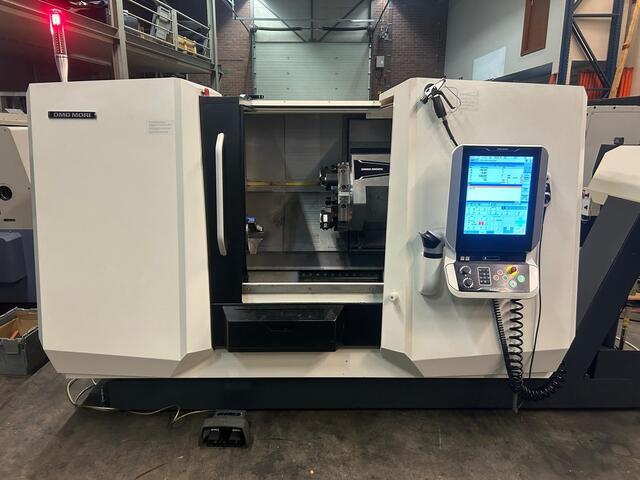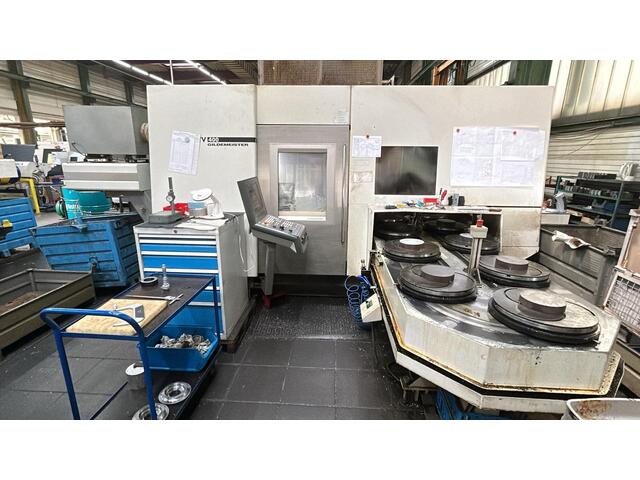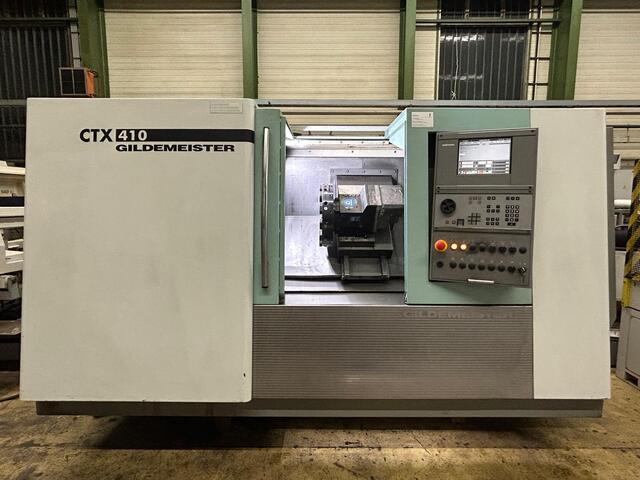- CNC Turning / Millingcenter
Year: 2020
DMG MORI SLIMline® (19"/ Operate 4,7 auf SIEMENS), Year 2020, Turnlenght 800, Ø 400, swing 650, Bar-Ø 80, C-Axes, [rpm] 4.000, kW 25,5 / 17, [Nm] 426 / 283, Tailstock Hydraulisch verfahrbarer Reitstock über M-Funktion, Turrets 1, Tools 12 x VDI-40 / 6 x BMT um die Revolverscheibe, Tool: VDI 40, driv. Tools, Y: [+/-] 60 mm, Bar loader magazine Hydrafeed MV 65 - Vertical CNC-Lathe
Year: 2008
Vertical Lathe, Sinumerik 840D powerline (XP), Year 2008, X: 700, Z: 340, C-Axes, [rpm] 3.500, kW 47, [Nm] 1.100, Turrets 1, Tools 12, driv. Tools 12, Tool: VDI 50, Pal. 15 - CNC - lathe machine
Year: 2003
Heidenhain CNCPilot 4290, Year 2003, [h] 11.080, Ø 420, Bar-Ø 67, Turnlenght 600, [rpm] 25 - 5.000, kW 28 / 21, X: 250, Z: 600, Tools 12, Tool: VDI 30, Tailstock
Haven't found the right machine?
Contact us - we will find the right machine for you!
Used lathes at Stenzel
Are you looking for used lathes in top condition at favorable conditions? At Stenzel you will find a large selection of used lathes. Whether it's a cycle lathe, universal lathe or turning center - we offer the right machine for every need. Our experts place the highest value on quality, precision and service. Every lathe is carefully inspected and maintained by us and is ready for immediate use.
We take care of the entire process for you when you buy used lathes: from advice and transportation to commissioning your machine. This means you not only receive first-class technology, but also an all-round service that leaves nothing to be desired.</p Get a quote now!
Tip: In addition to lathes, we also offer numerous used machine tools - from milling machines and machining centers to high-precision CNC systems. This allows you to expand your production efficiently and cost-effectively.
Your advantages with Stenzel
- Large selection of tested lathes and turning machines
- Comprehensive, solution-oriented advice
- Fast and uncomplicated processing
- Organization of transport & commissioning
- Over 100 years of experience in the machinery trade
Types and designs of modern lathes
Whether conventional lathe or CNC lathe - at Stenzel you will find machines in a wide variety of designs with individual advantages.
A CNC lathe or a CNC milling center enables precise turning and milling in a single operation. Thanks to computer-aided control, it offers maximum flexibility and accuracy when machining complex workpieces.
Vertical CNC lathes are space-saving and particularly suitable for smaller workpieces. Due to their vertical alignment, access to the workpiece is much easier.
A cycle lathe, on the other hand, is a cost-effective solution for standardized production tasks with high repeat accuracy - ideal for companies that want to produce precise but simple series.
Structure & mode of operation in metalworking
The basis of every lathe is the machine bed. On it is the headstock, which drives the main spindle. A tailstock supports the workpiece and enables longer parts to be machined. The feed system ensures the movement of the tool, while the tool system consisting of holders, turrets and slides ensures precise machining.
Before you buy a used lathe, you should check how many tool turrets you need to carry out operations efficiently without having to change tools.
Suitable materials for turning
Turning machines are versatile and suitable for a wide range of materials. They are most commonly used in metal processing - for machining steel, stainless steel, aluminum, copper or brass.
However, plastics such as PVC, ABS, polyethylene or polypropylene can also be turned precisely with the right tool selection and cooling.
Use in industry & manufacturing
Turning machines are an integral part of modern manufacturing. They are used in almost all branches of industry:
- Automotive industry: Production of precise components for engines and gearboxes.
- Aerospace: Production of complex lightweight components with tight tolerances.
- Machine and tool construction: Production of precise molds and components.
- Medical technology: Production of implants and surgical instruments.
- Laboratory and analysis technology: Machining of small, complex precision parts.
Thanks to CNC control, modern lathes can perform several work steps in a single pass: Turning, drilling, milling - all in one machine. This saves time, reduces costs and increases precision.
Used lathes - economical and precise
Buying a used lathe is both economical and sustainable. You receive tested brand machines - e.g. from DMG, Doosan, Hermle or Gildemeister - at significantly more favorable conditions. Used models are available immediately and are usually already optimally trained, which makes it easier to start production.
- Cost savings compared to new machines
- Quick availability - no long delivery times
- Tested quality with immediate operational readiness
- Sustainability through reuse of existing machines
Purchasing advice: How to find the right machine
- Material and workpieces: What do you want to process?
- Space requirements: How big can the machine be?
- Requirements: What speeds, tools and machining types are required?
- Condition: Has the machine been regularly serviced?
- Supplier: Only buy from reputable dealers with a guarantee and advice.
How the purchase process works at Stenzel
- Analyze requirements: We determine your requirements together.
- Suggest suitable machines: Selection from tested used machines
- Visit & test: You see the machine in action.
- Transport & assembly: We deliver, assemble and commission.
- After-sales service: Maintenance, spare parts and support included.
You can not only buy used lathes from us, but also many other machines such as milling machines and machining centers, automation or other machines.
FAQ - Answers to lathes and tool technology
What does a used lathe cost?
Prices start at around €500 for simple models and can go up to several hundred thousand euros, depending on the equipment and manufacturer.
Which manufacturers are recommended?
Popular brands include DMG Mori, Doosan, Mazak, Gildemeister and Hermle - all known for precision and durability.
How do I recognize the condition of a used lathe?
Look for maintenance certificates, year of manufacture, operating hours and condition of the guides. At Stenzel, all machines are checked before sale.
Can I test the machine before I buy it?
Yes, we offer test runs and on-site inspections on request.
Does Stenzel also offer transportation and installation?
Yes, our team organizes transport, installation and commissioning - all from a single source.
Conclusion: quality and confidence when buying
With over 100 years of experience in the machine trade, Stenzel is your reliable partner for used CNC lathes. Benefit from tested quality, professional service and individual advice - for production at the highest level.





